GCN/MOA Gravitational Lensing Event Notices
The MOA team stopped providing the "Amax" value in their messages (starting with the 2013 season).
So the "Max_Mag" and "Amplification" fields in the Notices will be filled with 0' sin the binary packats,
and the "string "No longer available" in the email-based formats. [GCN Ops, 20-Feb-13]
TABLE OF CONTENTS:
- Introduction
- Notice types, Content, and Purpose
- Positions, and Time_delays
- Formats
- Filtering
- Error Boxes
- Occurrance Rate
- Test Notices
- Recognition
- Guidance to the Follow-up Observer
- Further Help
- E-mail Example
- Cell/Pager Example
- Short-form Cell/Pager Example
- Subject-only Cell/Pager Examples
- VOEvent (XML) Example
Introduction
The Microlensing Observations in Astrophysics (MOA) instrument
detects gravitational lensing events of stars and planets
passing in front of stars in the Galactic Bulge (BLG).
The MOA telescope is located at Mt. John U. Observatory, New Zeland.
The GCN system has been modified to incorporate the distribution
of these events so that follow-up observations can be made of the lensing event lightcurve.
MOA detects about 60 lensing events per month (during the ~9 months/yr when the BLG is a night-time object).
Most of the time (2/3), these Notices are issued before the actual maximum in lensing lightcurve.
You have the opportunity to catch the main part of the event -- where most of the information on the lensing object is derived.
Below is a typical MOA lightcurve for a lensing event
(2011-BLG-160).
The top panel is an expansion of the bottom panel around the cusp. The cusp is roughly 5 days wide.
In this case the cusp is undersampled and would have benefitted from data points from other follow-up observers.
(For this particular event, the MOA message was issued ~24 hours before the cusp.)
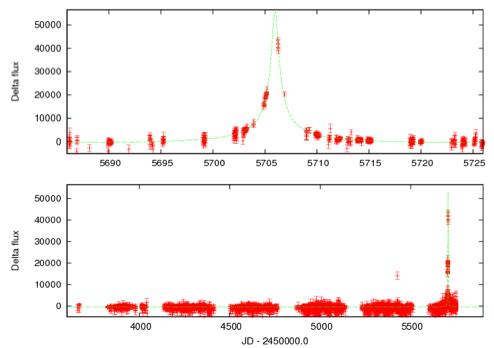
Sequence of Data Flow and Processing
MOA telescope observes a field (many fields per night);
images are processed and compared to previous observations;
looking for a field star that is brightening.
If the shape of the lightcurve is proper (for a lensing event, and not some variable star),
then a lensing event message is sent to GCN.
GCN puts it into the standard format and content
and sends it to those sites requesting this notice type and that meets their filtering criteria.
All the GCN/MOA Notices are also archived within the GCN website in the Table of MOA Events.
Notice Types, Content, and Purpose
There is only 1 GCN/MOA Notice type. It contains information about a gravitational lensing event.
The Notices contain an RA,Dec location of the lensed star.
Of particular interest to the follow-up observer is that the notice contains a prediction
when the cusp in the lightcurve will happen.
It also contains a measure of the duration of the lensing event (the width of the cusp).
Measurements around the cusp are most important.
The maximum expected magnitude of the cusp plus the baseline mag are also given.
The 4 figures below show the distribution base magnitudes of the lensed stars
and the distribution of predicted delta_magnitude decreases.
Both are shown in histrogram form and percentile distribution.
(Mag decreases greater than 10 are most likely due to spurious data points and sparse fitting.)
Note that 50% of these events have a delta_mag decrease of 2 or more magnitides.
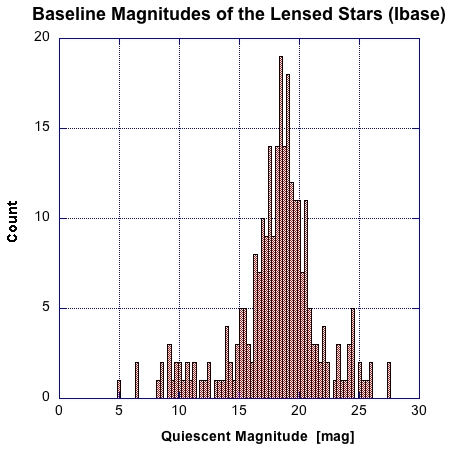
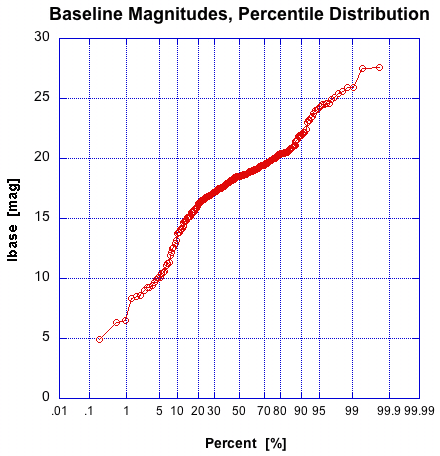
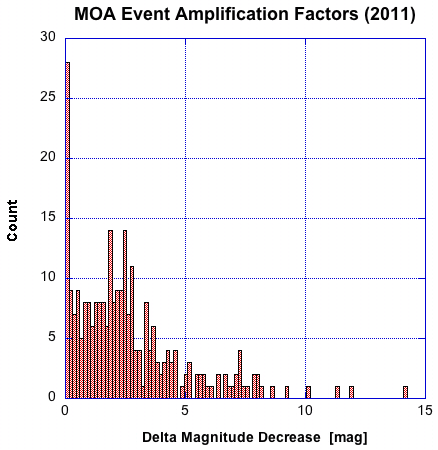
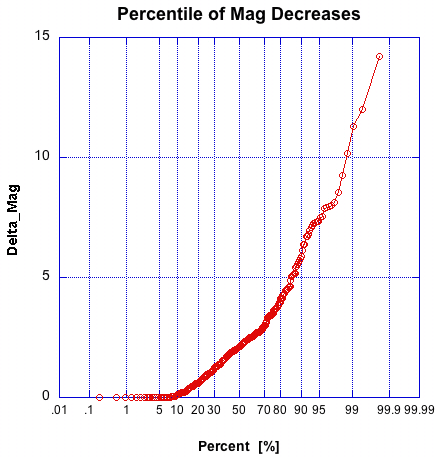
Positions and Time_delays
The automated MOA analysis software finds the events and sends the message to GCN.
Most of the time (2/3), the detections are made on the rising edge of the lensing event.
(1/3 of the notices are issued after the cusp, and many of those are still
on the steep portion of the decrease.) As such there is no delay like in most GCN notifications;
these notices are issued before the cusp occurs.
The distribution notification lead-time is shown in the figure below. (Positive values
are pre-cusp notifications; negative values are after the peak of the lightcurve cusp.)
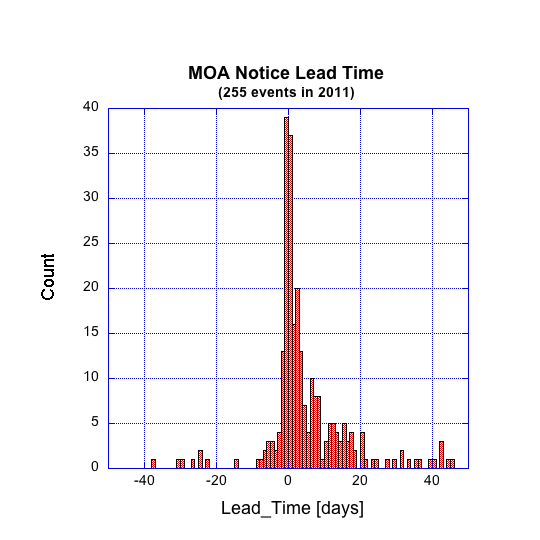
Formats
Samples of the E-mail, Cell/Pager, Short-form Cell/Pager, and Subject-only
distribution methods of the GCN/MOA Notice type is included below.
The format is very similar to the other spacecraft-instrument sources
of GRB and Transient locations -- the GCN-standard "TOKEN: value" format.
(Also available in XML format via email and sockets.)
The socket packet contents and format are similar to the other mission-specific packet types
and are described in detail in the socket packet definition document.
This document also has explanations of the various fields in the packet
(their content, values, and implications for use),
and those same fields are manifested in the email and cell/pager formats.
(Therefore, it is useful for email-based recipients to read the
socket packet definition document
to better understand the contents of the email/cell/pager notifications are.)
The MOA Notice is type=139.
Filtering
Sites can elect to receive the MOA Notice type.
The standard filtering applies to all the existing distribution methods/media.
Intensity:Of particular note, the "Intensity" filter is applied to the Peak_Magnitude. This is better than applying it
to the Delta_magnitude, because there is comparable variation in the baseline magnitudes
that these deltas ride on top of.
Time Delay:The TimeDelay filter is applied to the Maximum_Date_Time field (ie time of the cusp).
For example, if you have the Timedelay filter param to 100 hours, then you will not receive any notices
for which the Maxium intensity has already occurred more than 100 hours ago.
Error Boxes
The location error for the stars is better than 1 arcsec.
There is no ERROR (Token:value) field in the Notices because the value is always constant.
Occurrance Rate
MOA detects about 60 microlensing events per month for the ~9 months a year
that the Galactic Bulge is observable. In the years 2010 thru 2007, they announced
607, 563, 477, and 488, respectively.
False Positives
Less than 10% of these events will turn out to be nonlensing events
(ie cataclysmic variables (CVs), other variable stars; but even these
are astrophysical and are of some interest to some follow-up observers).
Test Notices
There are no test notices for this type.
Recognition
Here are the MOA Conditions of use of MOA data.
Sites are srongly encouraged to contribute their observatiosn to the MOA team
because no single site can sufficiently sample the lightcurve to achieve a significant fit.
Guidance to the Follow-up Observer
Here are some rough, very general ideas about making follow-up observations on these lensing events.
These are by no means absolute requirements -- just ballpark values and methods.
Seeing: The original MOA observations were done with 2-3 arcsec seeing.
Crowded Feilds: It is the Galactic Bulge, so these fields will be crowded (see MOA image below:
2011-BLG-160).
Filter: Any filter can be used. If different than the I filter used by MOA, then cross-calibration
with other stars in the field will be needed to allow your data point(s) to be added to the MOA lightcurve.
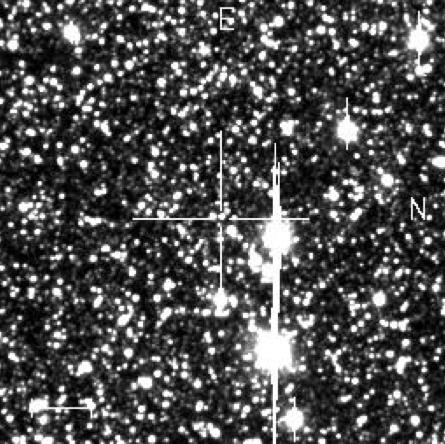
Misc
All the histogram and percentile plots on this page are based on the first ~255 MOA events in 2011.
Future Possibilites
At the moment (this initial release), there is no capabilty for an "Update" notice or a "Retraction".
Is it possible that Updates for things like:
(a) improved Max_Date_Time values,
(b) improved Amax values (as more of the rising edge of the cusp is available for a better fit),
(c) notifications of events that have planets involved in the micro-lensing, and
(d) retractions and/or reclassifications (eg lensing to CV)
will be implemented.
Further Help
For further information on this, please contact
Scott Barthelmy (for GCN issues),
or see the
MOA webpage (for MOA-specific questions),
and
these GCN web pages, and
GCN/MOA Events table.
E-mail Example
An example of the MOA Notice type of the e-mail format is shown below.
The "/////" divider bars are NOT part of the messages.
Do not take the actual values shown in these examples as a real lensing event.
While based on data from the MOA project,
they have been adjusted to provide a broader representation
of the various combinations of fields and value ranges.
For those sites/people that use demons and/or incoming e-mail filters,
the "Subject" line is: GCN/MOA_Lensing_Event .
///////////////////////// Full e-mail format ///////////////////////////
TITLE: GCN/MOA NOTICE
NOTICE_DATE: Wed 22 Jun 11 20:15:20 UT
NOTICE_TYPE: MOA Lensing Event
SRC_ID_NUM: 201100239
SRC_RA: 269.4659d {+17h 57m 52s} (J2000),
269.6487d {+17h 58m 36s} (current),
268.6689d {+17h 54m 41s} (1950)
SRC_DEC: -29.3406d {-29d 20' 25"} (J2000),
-29.3411d {-29d 20' 27"} (current),
-29.3361d {-29d 20' 09"} (1950)
PEAK_MAG: 12.7 mag (estimated)
DISCOVERY_DATE: 15733 TJD; 172 DOY; 11/06/21
DISCOVERY_TIME: 42973.00 SOD {11:56:13.00} UT
LEAD_TIME: 1.563 [days]
MAX_DATE: 15735 TJD; 174 DOY; 11/06/23
MAX_TIME: 5183.00 SOD {01:26:23.00} UT
MAX_UNCERT: 0.126 [days]
CUSP_WIDTH: 9.810 +/- 0.400 [days]
BASE_MAG: 12.68 +/- 0.34 mag
AMPLIFICATION: 1.01 factor
LC_URL: https://it019909.massey.ac.nz/moa/alert/display.php?id=gb9-R-3-32494
SUN_POSTN: 91.16d {+06h 04m 39s} +23.43d {+23d 25' 59"}
SUN_DIST: 173.94 [deg]
MOON_POSTN: 352.37d {+23h 29m 29s} +2.47d {+02d 28' 13"}
MOON_DIST: 84.88 [deg]
MOON_ILLUM: 56 [%]
GAL_COORDS: 1.02, -2.51 [deg] galactic lon,lat of the burst (or transient)
ECL_COORDS: 269.53, -5.90 [deg] ecliptic lon,lat of the burst (or transient)
COMMENTS: MOA Gravitational Lensing Event.
////////////////////////////////////////////////////////////////////////
Cell/Pager Example
An example of the (regular) cell/pager format is shown below.
There are no "Subject" lines for these e-mails sent to the cell/pager companies
because the Subject line would use up valuable character counts
from the maximum displayable for the body of the message.
RA,Dec values are in Current epoch.
///////////////////////// Cell/Pager format ////////////////////////////////
GCN/MOA
Lensing Event
RA=269.649d DEC=-29.341d
MAX_DATE= 11/06/23
MAX_TIME= 01:26:23.00 UT
MAX_UNCERT= 0.126 [days]
MAX_MAG=12.7
////////////////////////////////////////////////////////////////////////////
Short-form Cell/Pager Example
An example of the short-form cell/pager format is shown below.
There are no "Subject" lines for these e-mails sent to the cell/pager companies,
because the Subject-line would use up valuable character counts from the maximum
displayable for the body of the message. And it was the very limited
display character count of some companies that motivated the short-form cell/pager
method in the first place. RA,Dec are in B1950 epoch.
///////////////////////// Short-Cell/Pager format ////////////////////////////
MOA
Lensing Event
RA=268.669 DEC=-29.336d
LeadT=0.574d [days]
//////////////////////////////////////////////////////////////////////////////
Subject-only Examples
There are two variations of the Subject-only format: decimal degrees (Current epoch)
and RA=hh:mm:ss Dec=DDdMMmSSs format (J2000 epoch). The two variations are shown below:
///////////////////////// Subject-only format ////////////////////////////
MOA RA=269.649 DEC=-29.341d
//////////////////////////////////////////////////////////////////////////
MOA RA=+17:57:52 DEC=-29:20:25
//////////////////////////////////////////////////////////////////////////
VOEvent (XML) Example
An example of the VOEvent XML format is shown below.
This can be delivered as the body of a email message, or
as an attachment to the (full-format) E-mail format, or
via the XML_SOCKET method.
<?xml version = '1.0' encoding = 'UTF-8'?>
<voe:VOEvent
ivorn="ivo://nasa.gsfc.gcn/MOA#Lensing_Event_2011-06-21T11:56:13.00_0201100239-0-170"
role="observation" version="1.1"
xmlns:voe="http://www.ivoa.net/xml/VOEvent/v1.1"
xmlns:xsi="http://www.w3.org/2001/XMLSchema-instance"
xmlns:xlink="http://www.w3.org/1999/xlink"
xsi:schemaLocation="http://www.ivoa.net/xml/VOEvent/v1.1 http://www.ivoa.net/xml/VOEvent/VOEvent-v1.1.xsd" >
<Who>
<AuthorIVORN>ivo://nasa.gsfc.tan/gcn</AuthorIVORN>
<Author>
<shortName>MOA (via VO-GCN)</shortName>
<contactName>Ian Bond</contactName>
<contactPhone>+nn-nnn-nnn-nnnn</contactPhone>
<contactEmail>I.A.Bond@massey.ac.nz</contactEmail>
</Author>
<Date>2011-06-22T20:15:20</Date>
<Description>This VOEvent message was created with GCN VOE version: 1.4 04jun11</Description>
</Who>
<What>
<Param name="Packet_Type" value="139" />
<Param name="Pkt_Ser_Num" value="8" />
<Param name="TrigID" value="201100239" ucd="meta.id" />
<Param name="Burst_TJD" value="15733" unit="days" ucd="time" />
<Param name="Burst_SOD" value="42973.00" unit="sec" ucd="time" />
<Param name="Burst_intenX" value="1267" unit="cts" ucd="phot.count" />
<Param name="Burst_intenY" value="0" unit="cts" ucd="phot.count" />
<Param name="t1" value="0.00" unit="sigma" ucd="stat.snr" />
<Param name="t2" value="1.01" unit="sigma" ucd="stat.snr" />
<Param name="t3" value="5183.00" unit="sec" ucd="time.interval" />
<Param name="Trigger_ID" value="0x0" />
<Param name="Misc_flags" value="0x0" />
<Group name="Trigger_ID" >
</Group>
<Group name="Misc_Flags" >
<Param name="Near_Bright_Star" value="false" />
<Param name="Err_Circle_in_Galaxy" value="false" />
<Param name="Galaxy_in_Err_Circle" value="false" />
<Param name="Flt_Generated" value="true" />
<Param name="Gnd_Generated" value="false" />
</Group>
<Param name="Coords_Type" value="1" unit="dn" />
<Param name="Coords_String" value="source_object" />
<Group name="Obs_Support_Info" >
<Description>The Sun and Moon values are valid at the time the VOEvent XML message was created.</Description>
<Param name="Sun_RA" value="91.16" unit="deg" ucd="pos.eq.ra" />
<Param name="Sun_Dec" value="23.43" unit="deg" ucd="pos.eq.dec" />
<Param name="Sun_Distance" value="173.94" unit="deg" ucd="pos.angDistance" />
<Param name="Sun_Hr_Angle" value="-11.90" unit="hr" />
<Param name="Moon_RA" value="352.37" unit="deg" ucd="pos.eq.ra" />
<Param name="Moon_Dec" value="2.47" unit="deg" ucd="pos.eq.dec" />
<Param name="MOON_Distance" value="84.88" unit="deg" ucd="pos.angDistance" />
<Param name="Moon_Illum" value="56.29" unit="%" ucd="arith.ratio" />
<Param name="Galactic_Long" value="1.02" unit="deg" ucd="pos.galactic.lon" />
<Param name="Galactic_Lat" value="-2.51" unit="deg" ucd="pos.galactic.lat" />
<Param name="Ecliptic_Long" value="269.53" unit="deg" ucd="pos.ecliptic.lon" />
<Param name="Ecliptic_Lat" value="-5.90" unit="deg" ucd="pos.ecliptic.lat" />
</Group>
<Description>The MOA detection of a gravitational lensing event.</Description>
</What>
<WhereWhen>
<ObsDataLocation xmlns="http://www.ivoa.net/xml/STC/stc-v1.30.xsd">
<ObservatoryLocation xlink:href="ivo://STClib/Observatories#GEOLUN/" xlink:type="simple" id="GEOLUN" />
<ObservationLocation>
<AstroCoordSystem xlink:href="ivo://STClib/CoordSys#UTC-FK5-GEO/" xlink:type="simple" id="FK5-UTC-GEO" />
<AstroCoords coord_system_id="FK5-UTC-GEO">
<Time unit="s">
<TimeInstant>
<ISOTime>2011-06-21T11:56:13.00</ISOTime>
</TimeInstant>
</Time>
<Position2D unit="deg">
<Name1>RA</Name1>
<Name2>Dec</Name2>
<Value2>
<C1 pos_unit="deg">269.4659</C1>
<C2 pos_unit="deg">-29.3406</C2>
</Value2>
<Error2Radius>0.1268</Error2Radius>
</Position2D>
</AstroCoords>
</ObservationLocation>
</ObsDataLocation>
<Description>The RA,Dec coordinates are of the type: source_object.</Description>
</WhereWhen>
<How>
<Description>MOA Instrument</Description>
<Reference uri="http://gcn.gsfc.nasa.gov/moa.html" type="url" />
</How>
<Why importance="1.0">
<Inference probability="1.0">
<Concept>process.variation.burst;em.gamma</Concept>
</Inference>
</Why>
<Description>
</Description>
</voe:VOEvent>
Return to GCN/TAN homepage.
This file was last modified on 20-Feb-13.






